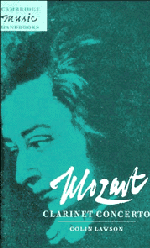Book contents
- Frontmatter
- Contents
- List of illustrations
- Preface
- 1 The eighteenth-century clarinet and its music
- 2 Mozart, Stadler and the clarinet
- 3 The genesis and reception of the Concerto
- 4 Stadler's clarinet and its revival
- 5 Mozart's original text
- 6 Design and structure
- 7 Performance practice
- Appendix 1 A review of the Breitkopf and Härtel edition in the Leipzig Allgemeine Musikalische Zeitung, 4 (March 1802)
- Appendix 2 Surviving instruments
- Appendix 3 A list of works composed by Mozart's clarinettist, Anton Stadler
- Notes
- Select bibliography
- Index
3 - The genesis and reception of the Concerto
Published online by Cambridge University Press: 05 June 2012
- Frontmatter
- Contents
- List of illustrations
- Preface
- 1 The eighteenth-century clarinet and its music
- 2 Mozart, Stadler and the clarinet
- 3 The genesis and reception of the Concerto
- 4 Stadler's clarinet and its revival
- 5 Mozart's original text
- 6 Design and structure
- 7 Performance practice
- Appendix 1 A review of the Breitkopf and Härtel edition in the Leipzig Allgemeine Musikalische Zeitung, 4 (March 1802)
- Appendix 2 Surviving instruments
- Appendix 3 A list of works composed by Mozart's clarinettist, Anton Stadler
- Notes
- Select bibliography
- Index
Summary
The newly invented clarinet
A surviving programme for a concert on 20 February 1788 documents an important milestone in the history of Mozart and Stadler, heralding the arrival of the newly extended clarinet. It announces a concert at the Hoftheater at which ‘Herr Stadler the elder, in the service of his majesty the Kaiser, will play a concerto on the Bass-Klarinet and a variation on the Bass-Klarinet, an instrument of new invention and manufacture of the court instrument maker Theodor Loz [sic]; this instrument has two more tones than the normal clarinet’. In the same concert were given a symphony by Hayden [sic] and the first performance of J. F. Reichardt's Ariadne auf Naxos. Stadler's instrument has become known in recent times as the basset clarinet, a term coined by Jirí Kratochvíl to reflect its kinship with the basset horn. This labelling avoids confusion with the bass clarinet, whose orchestral career developed only during the nineteenth century. It seems reasonable to assume that the special clarinet referred to in 1788 had a diatonic extension of c and d, by analogy with the basset horn in normal use. It was probably pitched in B♭ Backofen's tutor (c. 1803) shows awareness of such an instrument: ‘Another more recent and excellent invention is this, that clarinets with d and c are now being made in Vienna; this greatly improves the clarinet, because in addition to the great advantage which low c brings, which until now it missed so much in its favourite key of C, it now has three complete octaves, in which every clarinettist can play easily’.
- Type
- Chapter
- Information
- Mozart: Clarinet Concerto , pp. 25 - 42Publisher: Cambridge University PressPrint publication year: 1996



